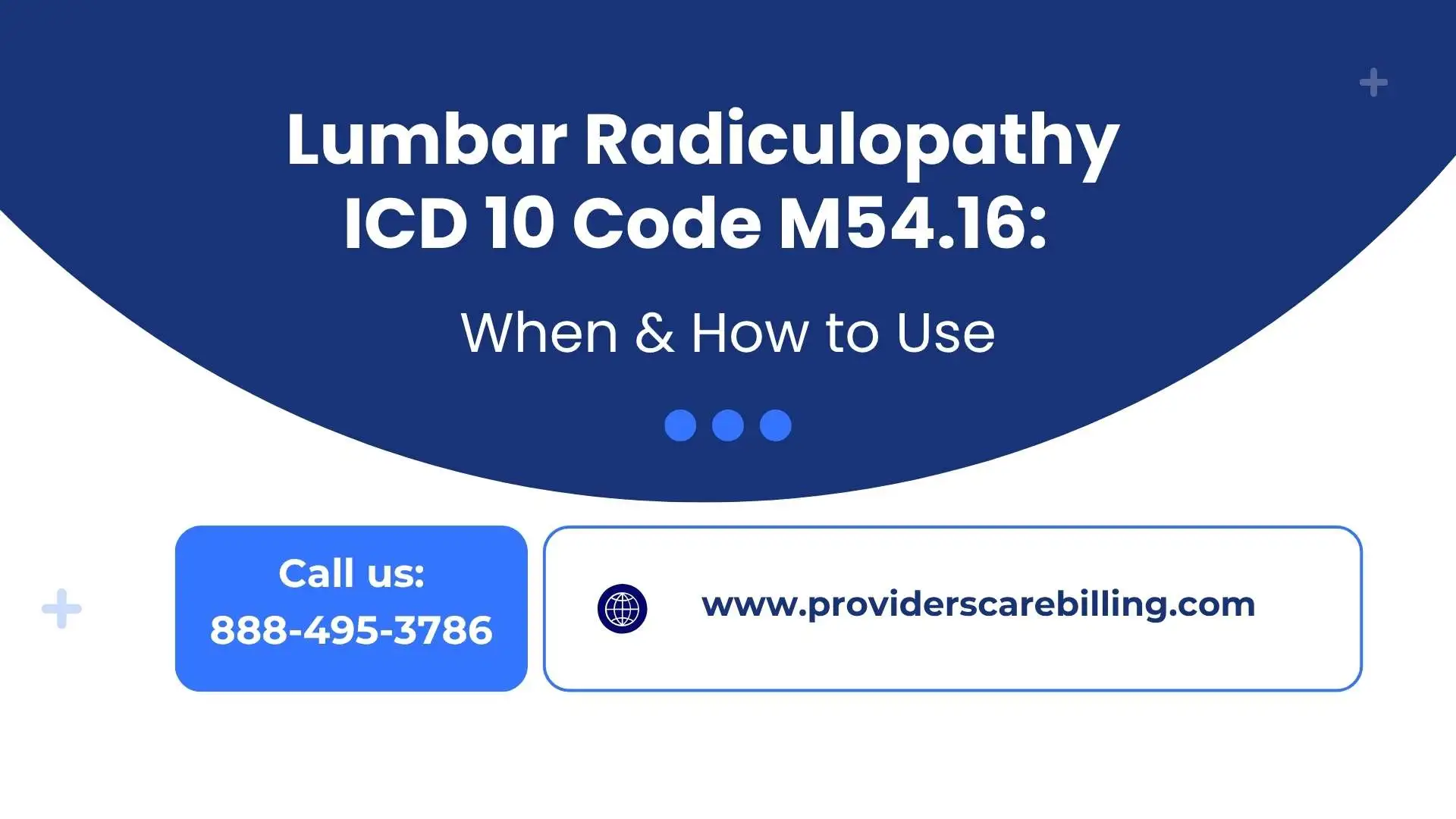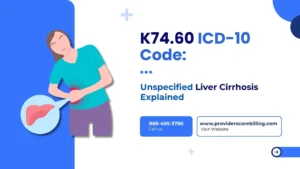In addition to ensuring all paperwork, maximum revenue, and audit avoidance, ICD 10 complies with the definition of the target key term “Lumbar radiculopathy”. M54.16 is correctly coded, taking on the meaning of involvement of nerve roots, allowing a correct treatment and a better billing. The coding is accurate with professional Medical billing services, and working with a Medical billing Company guarantees you a Medical billing that is reasonable in terms of legal compliance and trend towards good financial performance. Providers Care Billing LLC is such a bridge between documentation and the performance of the revenue cycle.
Do you know that ignoring the description of lumbar radiculopathy, which may be marked as general low back pain (M54.5), provides a higher number of broken claims and patient outcomes? Research indicates that proper utilization of M54.16 will increase reimbursement by an average of 25 percent and will lessen the threat of audit by 50 percent or more, particularly for claims related to intervertebral disc disorders.
What is Lumbar Radiculopathy?
A problem with the nerve root of the lower area is called radiculopathy of the lumbar region. In other words, the nerve roots of the lower area are either crowded or irritated, and it is most likely due to disc herniation, spondylosis, or stenosis, resulting in pain, numbness, tingling, or weakness that radiates into the leg or both legs. Lumbar radiculopathy is a term referring to deficit or irritation of the lower back nerve roots, and it is often associated with compression, inflammation, or secondary to other mechanical disorders. A condition may affect single or multiple nerve roots, between the first lumbar vertebra (L1) to the fifth (L5), and even further to the sacral area, potentially leading to lower back pain.
Lumbar Radiculopathy symptoms:
- Pain in the lower back.
- Tingling.
- Numbness.
- Muscle Spasm.
Your symptoms are dependent on what kind of radiculopathy you have.
1. Cervical radiculopathy:
Your hands and arms may also be affected by the pain and other symptoms you are experiencing in and around your neck.
2. Thoracic radiculopathy:
Pain in and around your chest, notably during inhalation and exhalation, may also be associated with referred pain from the thoracic spine.
3. Lumbar radiculopathy:
Your legs may become numb or experience lower back pain.
How is the diagnosis of radiculopathy made?
Radiculopathy can be identified by your healthcare provider through a battery of imaging tests and physical examinations. They will take a closer look at your back and spine, ask you a number of questions about your symptoms and how you feel in general to discover a number of feelings you are experiencing.
It is likely that you may require at least one of several imaging tests, such as:
- X-ray
- Computed Tomography (CT) Scan
- EMG
- MRI
Clinical Standards for the Diagnosis of M54.16
A comprehensive knowledge of clinical manifestations is needed. The patients with lumbar radiculopathy complain of:
- Pain in the back that can be sharp or burning in character and that spreads to the leg, one at a time, or both at once.
- These sensory disturbances include numbness or tingling in the dermatomal distribution.
- Increasing symptoms of motion, cough, or sneeze.
- The weakness of muscles in the affected limb.
In extreme cases, patients could face changes in gait, balance, or even bladder/ bowel dysfunction, and this is a condition that must be treated immediately.
Patients with lumbar radiculopathy may also experience metabolic imbalances that affect neurological function. For detailed information on coding and documenting metabolic encephalopathy, see our comprehensive guide on ICD-10 for Metabolic Encephalopathy G93.41: When & How to Use.
Scenario
A 48 years old warehouse employee noticed numbness and burning sensations on his right leg. An MRI showed that the L5 nerve root had a compressed herniated disc that was compressed. His diagnosis? Lumbar radiculopathy. His proper utilization of M54.16 secured his insurance in paying out the intricacy of imaging, physical therapy, and subsequently, a minimally invasive procedure.
ICD 10 Codes for Lumbar Radiculopathy
| Code | Description | Use |
| M51.16 | Radiculopathy in the lumbar region with intervertebral disc disorder can often lead to significant discomfort. | Where the diagnosis of disc herniation implies radiculopathy by MRI or clinical implication |
| M54.16 | Radiculopathy in the lumbar area | Its Primary diagnosis: lumbar radiculopathy (nerve root compression of the lower back) |
| M54.30 | Sciatica | Main diagnosis: Lumbar radiculopathy (squeezy nerves at the lower back) |
| M54.9 | Dorsalgia, unspecified | Way too vague – to be avoided when at all possible |
The Value of Precise Coding
Inaccurate coding results in:
- Rejected or postponed claims
- Audits of payments
- A decrease in patient satisfaction
- Leakage of revenue
M54.16 Codes Most Frequently Connected with CPT Codes
The following Current Procedural Terminology (CPT) codes are normally used in billing lumbar radiculopathy:
- 99214 – The Complexity of established patient visits is moderate.
- 72148 – Without contrast MRI lumbar spine.
- 64483 – Steroid injection in epidural lumbar.
- 20552 – Associated muscle pain using trigger point injection.
Is your practice having trouble with proper coding or rejection of insurance?
Allow Providers Care Billing LLC to alleviate the burden on your team. Our Medical Coding Services and Revenue Cycle Management Services are executed by professionals who are experts who take care of your M54.16 claims, cleaning up, speeding, and with full reimbursement.
📞 Call Now: 888-495-3786
📧 Email: Info@providerscarebilling.com
Can the M54.16 be billed?
You are correct; the International Classification of Diseases, 10th revision, clinical modification (ICD-10-CM) coding system includes M54.16 Lumbar region radiculopathy as one of the coded billable diseases. Any medical care provider, insurance company (such as Medicaid), and musculoskeletal statistics can be charged for it.
Conclusion
In the modern billing environment, where billing accuracy is very important in reimbursement and effective treatment of patients, it is important to use ICD-10 code M54.16 properly when it comes to lumbar radiculopathy. Each of these details is important: documentation, diagnosis, procedural coding, claims submission, and ensuring accurate coding for intervertebral disc disorders. Denials in healthcare can be drastically reduced, revenue can be dynamic and ever-increasing, and reimbursements can be compliant with all the changing rules when the appropriate strategies are put in place, with the help of a trusted Medical Billing Company.
FAQS
Q: Does CPT code M54.16 identify as the same as the ICD-10 code?
No. M54.16 is specifically used for coding intervertebral disc disorders affecting the lumbar region. CPT codes cover procedures.



